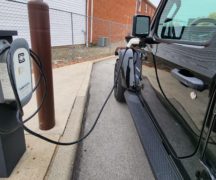BY NICK EVANS
State officials announced $18 million in federal funding to support the development of 27 new electric vehicle fast charging stations. The money comes from the bipartisan infrastructure package approved by congress in 2021. Private businesses will invest another $6 million in the current buildout.
Gov. Mike DeWine unveiled the locations in a sprawling garage just west of Columbus. The Ohio Department of Transportation facility houses the massive snow plows the agency deploys on freeways come winter. For Thursday’s announcement though, two Ford plug-in EVs flanked the governor.
“Today we have about 52,600 Ohioans who drive EVs,” DeWine explained next to a map of the new locations. “As more Ohioans purchasing these, we want to make sure our infrastructure is prepared to accommodate them.”

The NEVI program
Ohio’s freeways blanket the state in something like a cross between a spider web and a grid. Along those blue lines, the ODOT map placed a red star for each planned charging station. The project puts a fast charging station every 50 miles or so along Ohio’s freeways.
“These chargers, like ones that we have here,” DeWine said pointing to one at his side, “will include at least four ports to plug in to and will be open 24 hours a day once they are installed next year.”
Funding for the effort comes from the National Electric Vehicle Infrastructure, or NEVI, Program. In sum, Ohio will receive $140 million in NEVI funds over the next five years. ODOT Director Jack Marchbanks said that investment will help ease concerns like “range anxiety” that might deter potential EV buyers.
“A year from now when these new stations start operating throughout the state EV drivers can be confident that a charge will be available for them when needed,” he said.
Among the sites selected are existing travel centers and retail shops including grocery stores. Every charging station site will be less than a mile from the freeway. A press release identifies Meijer, Pilot Travel Centers and Shell as some of the private partners. The awards range from as little as $177,000 up to $790,000, but most land around $675,000.
Although the Ohio Turnpike has begun building out EV charging infrastructure at its rest stops, DeWine explained federal limits on privatization bar the state from doing something similar along the interstate.
“Maybe Congress could look at that,” DeWine said.
Buildout
Thursday’s announcement represents just the first phase in Ohio’s NEVI plans. DriveOhio Executive Director Preeti Choudhary explained they’re already working to expand their reach to smaller highways.
“DriveOhio has already commenced work on round two of its NEVI program rollout,” she said. “In round two alone, we’ll look to build at least 16 stations along U.S. and state routes.”
DeWine emphasized their plans to build out beyond the freeways — “the first question I asked the team,” he said. He explained once Ohio gets to the third phase officials will have even more flexibility.
“We will have the ability to fill these in a lot better,” DeWine said, looking to the broad open space in southern Ohio. “You’ll see it filled in more even in the second round as well.”
“You look at (U.S. Route) 23 coming out of Columbus, obviously, going straight down to the river, that’s a logical place. There’s many other logical places as well,” he added.
DriveOhio is also working with ODOT on developing signage so that drivers on the freeway know where to exit.
“We’re working with our planning group and thinking about updates to the blue signs that you see, the wayfinding signs, that show the next fueling station,” she said. “We’re trying to figure out how we can expand those and indicate EV charging.”
DeWine and Choudhary bragged about how rapidly Ohio has moved to launch its NEVI program. And Federal Highway Administration deputy administrator Andrew Rogers praised their efforts, too. Even though, as a Michigan native, he expected to get grief for it back home.
“Between just securing the largest discretionary grants in USDOT history for the Brent Spence Bridge, to being among the first states launching its NEVI program and actually putting dots on the map, Ohio is absolutely leading the way by taking full advantage of the bipartisan infrastructure law and the resources it affords,” he said.
More headlines from Ohio Capital Journal:




